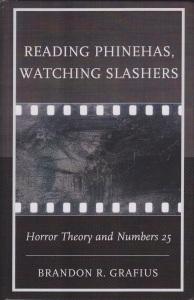 Let me relish this a moment.
Let me relish this a moment.
Thanks.You still there?It’s not too often, you see, that I get to feel like I’m near the front of the crowd.I began writing Holy Horror when there were a small handful of books on the market concerning horror and the Bible.I wasn’t aware of Brandon R. Grafius’ work at the time, but it sure is gratifying to see that others have noticed the connection.Reading Phinehas, Watching Slashers: Horror Theory and Numbers 25 is pretty much what its title says.I’ll be having more to say on it in a different venue—don’t worry, I’ll let you know—so I’ll keep to the basics here.My spellcheck, and I’m sure not a few others, might have trouble identifying Phinehas.
In one of those weird, short, violent episodes for which the Good Book is justly famous, the story of Phinehas is clearly part of a larger, untold narrative.Like the sons of the gods marrying the daughters of men in Genesis 6.The grandson of Aaron, Phinehas was one of the hereditary priests of early Israel.The Israelites wandering for their 40 years in the wilderness were nearly as xenophobic as the Trump Administration.When one of the chosen people chose a foreign wife, Phinehas, full of zeal, grabbed a spear and skewered the couple.Tradition says in flagrante delicto.This act of violence stops a raging plague sent by the Almighty, so Phinehas looks like a hero in context.If you want to read the story the subtitle tells you where to find it.Or you could read Grafius’ excellent book.
Horror, which should be already obvious, enters the picture in the form of theory.Yes, there is such a thing as horror theory.Grafius uses it to analyze this story, along with other methods.This is what I’m relishing.I certainly wasn’t the first to notice the connection.Many years ago Phyllis Trible wrote Texts of Terror, noting how the Bible seems less holy (my expression, not hers) when read from the perspective of a woman.Indeed, many accounts that seem like standard issue narratives of God laying down the rules and humans disobeying tend to fall pretty heavily on females.And the punishments used are fit for horror films.Grafius focuses specifically on slashers, but one gets the sense that this book is just the start of something larger.This reader, at least, hopes that is the case.
